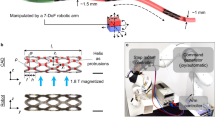Abstract
Nowadays, studies of the interventional micro robots have been hot topics in the field of medical device. The ultimate goal of medical micro robots is to reach currently inaccessible areas of the human body and carry out a host of complex operations such as minimally invasive surgery (MIS), highly localized drug delivery and opening up the blood vessels. Miniature, safe and energy efficient propulsion systems hold the key to mature this technology. In this paper, a prototype of endovascular micro robot based on the motion principle of spermatozoa is presented. The properties of this propulsive mechanism are estimated by modeling the dynamics of the swimming methods. In order to validate the theoretical results for spermatozoa propulsion, a scaled-up prototype of the swimming robot is fabricated and characterized in imitative bio-pipes full of silicone oil. Experimental results shown that the spermatozoa-like micro robot can be controlled to swim efficiently. And to adjust the rotation direction of the four flexible tails, the propulsion forces and the function of opening up the blood vessels will be generated.
Similar content being viewed by others
References
Wang G M, Shen L C, Wu Y H. Research on swimming by undulatory long dorsal fin propulsion. Frontiers of Mechanical Engineering in China, 2007, 2, 77–81.
Khalil W, Gallot G, Boyer F. Dynamic modeling and simulation of a 3-D serial eel-like robot. IEEE Transactions on Systems, Man, and Cybernetics, Part C: Applications and Reviews, 2007, 37, 1259–1268.
Guo S X, Ge Y M, Li L F, Liu S. Underwater swimming micro robot using IPMC actuator. Proceedings of the 2006 IEEE International Conference on Mechatronics and Automation, Luoyang, China, 2006, 249–254.
Zhang W, Guo S X, Asaka K. A new type of hybrid fish-like microrobot. International Journal of Automation and Computing, 2006, 3, 358–365.
Laurent G, Piat D. Efficiency of swimming microrobots using ionic polymer metal composite actuators. Proceeding of the 2001 IEEE International Conference on Robotics and Automation, 2001, 4, 3914–3919.
Kosa G, Shoham M, Zaaroor M. Propulsion method for swimming microrobots. IEEE Transactions on Robotics, 2007, 23, 137–150.
Mei T, Chen Y, Fu G Q, Kong D Y. Wireless drive and control of a swimming microrobot. Proceeding of the 2002 IEEE International Conference on Robotic and Automation, Washington, USA, 2002, 2, 1131–1136.
Zhong Y C. Study on dynamic model of novel micro robot mobile in liquid. China Mechanical Engineering, 2007, 18, 524–527. (in Chinese)
Zhang Y S, Liu W, Jia Z Y, Dai H Z. Biomimetic swimming properties of a wireless micro robot driven by outside magnetic field. Chinese Journal of Mechanical Engineering, 2005, 41, 51–56. (in Chinese)
Kamamichi N, Yamakita M, Asaka K, Luo Z W. A snake-like swimming robot using IPMC actuator/sensor. Proceedings of the 2006 IEEE International Conference on Robotics and Automation, Orlando, USA, 2006, 1812–1817.
Chen B, Gu D Q, Pan S X, Zhong J. Design of a tadpole-like swimming robot with spiral-type head. Chinese Journal of Mechanical Engineering, 2005, 41, 88–92. (in Chinese)
Sendoh M, Ishiyama K, Arai K I. Fabrication of magnetic actuator for use in a capsule endoscope. IEEE Transactions on Magnetics, 2003, 39, 3232–3234.
Chen B, Jiang S R, Gu D Q. Influence of operational environment on performance of spiral type endoscopic robot. Chinese Journal of Scientific Instrument, 2006, 27, 1391–1394. (in Chinese)
Zhou Y S, He H N, Gu D Q, An Q, Quan Y X. Noninvasive method to drive medical micro robots. Chinese Science Bulletin, 2000, 45, 617–620.
Behkam B, Sitti M. Design methodology for biomimetic propulsion of miniature swimming robots. Journal of Dynamic Systems Measurement and Control, 2006, 128, 36–43.
Behkam B, Sitti M. Modeling and testing of a biomimetic flagellar propulsion method for microscale biomedical swimming robots. Proceedings of the IEEE/ASME International Conference on Advanced Intelligent Mechatronics, Monterey, USA, 2005, 37–42.
Brennen C, Winet H. Fluid Mechanics of Propulsion by Cilia and Flagella. Annual Review of Fluid Mechanics, 1977, 9, 339–398.
Gray J, Hancock G. The propulsion of sea-urchin spermatoza. Journal of Experimental Biology, 1955, 32, 802–814
Johnson R E, Brokaw C J. Flagellar hydrodynamics: A comparison between resistive-force theory and slender-body theory. Biophysics Journal, 1979, 25, 113–127
Author information
Authors and Affiliations
Corresponding author
Rights and permissions
About this article
Cite this article
Chen, B., Liu, Yd., Chen, S. et al. A Biomimetic Spermatozoa Propulsion Method for Interventional Micro Robot. J Bionic Eng 5 (Suppl 1), 106–112 (2008). https://doi.org/10.1016/S1672-6529(08)60080-3
Published:
Issue Date:
DOI: https://doi.org/10.1016/S1672-6529(08)60080-3




